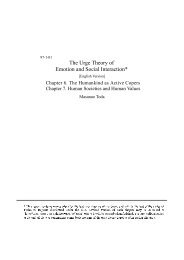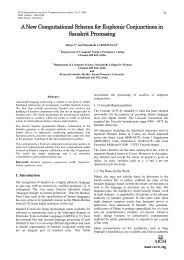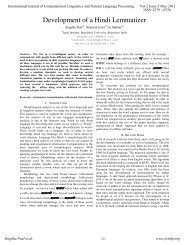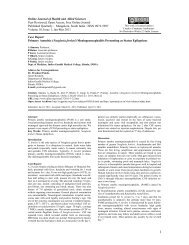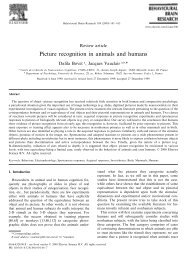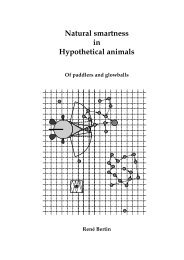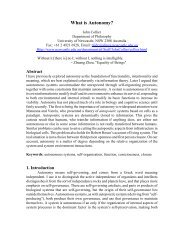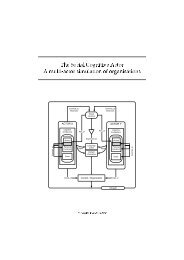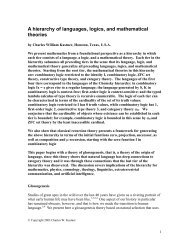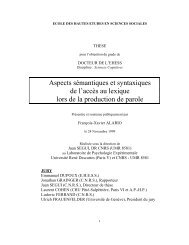Early imitation and the emergence of a sense of agency - Cogprints
Early imitation and the emergence of a sense of agency - Cogprints
Early imitation and the emergence of a sense of agency - Cogprints
You also want an ePaper? Increase the reach of your titles
YUMPU automatically turns print PDFs into web optimized ePapers that Google loves.
In Berthouze, L., Kozima, H., Prince, C. G., S<strong>and</strong>ini, G., Stojanov, G., Metta, G., <strong>and</strong> Balkenius, C. (Eds.)<br />
Proceedings <strong>of</strong> <strong>the</strong> Fourth International Workshop on Epigenetic Robotics<br />
Lund University Cognitive Studies, 117, ISBN 91-974741-3-4<br />
<strong>Early</strong> <strong>imitation</strong> <strong>and</strong> <strong>the</strong> <strong>emergence</strong> <strong>of</strong> a <strong>sense</strong> <strong>of</strong><br />
<strong>agency</strong><br />
Jacqueline Nadel<br />
CNRS UMR7593, Hôpital La Salpêtrière<br />
Paris, France<br />
e-mail: jnadel@ext.jussieu.fr<br />
In this paper, I would like to emphasize <strong>the</strong> developmental<br />
role <strong>of</strong> <strong>imitation</strong> as a foundation for <strong>the</strong><br />
<strong>emergence</strong> <strong>of</strong> a <strong>sense</strong> <strong>of</strong> <strong>agency</strong> (i.e. a <strong>sense</strong> <strong>of</strong> being<br />
<strong>the</strong> owner <strong>of</strong> one’s own action). There is a large body<br />
<strong>of</strong> psychological <strong>and</strong> neuroimaging experiments that<br />
have demonstrated that perception <strong>of</strong> action share<br />
some common neural <strong>and</strong> cognitive mechanisms with<br />
action generation, action simulation, action recognition<br />
<strong>and</strong> action <strong>imitation</strong>. How <strong>the</strong> concept <strong>of</strong> shared<br />
motor representations relate to neonatal <strong>imitation</strong> is<br />
<strong>of</strong> major interest. Indeed, primary wired perceptualmotor<br />
coupling may be viewed as primitives <strong>of</strong> <strong>imitation</strong><br />
which could play a main constitutive role in <strong>the</strong><br />
establishment <strong>of</strong> a distinction between action originating<br />
from self <strong>and</strong> action originating from o<strong>the</strong>rs.<br />
We will show that 2-month-olds do not imitate a selfpropelled<br />
robotic mouth protruding its tongue, while<br />
<strong>the</strong>y do imitate a human tongue protrusion. This<br />
suggests that <strong>imitation</strong> is already selective <strong>of</strong> human<br />
action. Young infants select biological movements<br />
among all moving stimuli that are similar in speed,<br />
colour <strong>and</strong> morphology.<br />
Similarly, be imitated may be viewed as an actionperception<br />
coupling which may strongly contribute<br />
to distinguish between self-<strong>agency</strong> <strong>and</strong> o<strong>the</strong>r’s<br />
<strong>agency</strong>. In her first developmental steps, <strong>the</strong> very<br />
young infant may take <strong>the</strong> behaviour seen as being<br />
hers, which could result in reciprocal <strong>imitation</strong> if <strong>the</strong><br />
movement seen does not match exactly <strong>the</strong> movement<br />
done. Through <strong>imitation</strong>, this will lead <strong>the</strong><br />
infant to distinguish between two classes <strong>of</strong> perception<br />
that Russell proposes to be at <strong>the</strong> origin <strong>of</strong> <strong>the</strong><br />
<strong>sense</strong> <strong>of</strong> <strong>agency</strong>: those perceptions that are a byproduct<br />
<strong>of</strong> one’s own action <strong>and</strong> intention, <strong>and</strong> perceptions<br />
coming from <strong>the</strong> external world, that you<br />
cannot modify at will. Comparing 2-month-olds’ behavior<br />
with a device allowing to present with a seamless<br />
shift contingent image <strong>and</strong> voice <strong>of</strong> <strong>the</strong> mo<strong>the</strong>r or<br />
delayed image <strong>and</strong>/or voice <strong>of</strong> <strong>the</strong> mo<strong>the</strong>r, we found<br />
10 times more <strong>imitation</strong> in <strong>the</strong> contingent episode,<br />
where infant <strong>and</strong> mo<strong>the</strong>r can reciprocate <strong>imitation</strong><br />
rounds. In addition, a high positive correlation between<br />
number <strong>of</strong> mo<strong>the</strong>r’s <strong>imitation</strong> <strong>and</strong> number <strong>of</strong><br />
infant’s <strong>imitation</strong> was found. This suggests that im-<br />
Figure 1: The teleprompter device used to delay image<br />
<strong>and</strong>/or voice <strong>of</strong> <strong>the</strong> mo<strong>the</strong>r (Nadel, Prepin & Canet,<br />
2004)<br />
itation begets <strong>imitation</strong> early after birth.<br />
In <strong>the</strong> past we have shown that synchronic <strong>imitation</strong><br />
<strong>and</strong> <strong>imitation</strong> recognition allow preverbal infants<br />
to find common topics based on similar actions,<br />
<strong>and</strong> to take conversational turns by alternating <strong>the</strong><br />
roles <strong>of</strong> imitator <strong>and</strong> model. Therefore <strong>the</strong> gap between<br />
recognizing actions <strong>and</strong> coding messages with<br />
communicative intent is not as enormous as it looks<br />
at first glance: Underst<strong>and</strong>ing <strong>the</strong> o<strong>the</strong>r’s intentional<br />
actions is prepared by <strong>the</strong> use <strong>of</strong> <strong>the</strong> imitative system,<br />
via <strong>the</strong> action recognition mechanism<br />
Our experiments led in socially embedded situations<br />
have shown that nonverbal children with<br />
autism - even very low-functioning children - mostly<br />
produce spontaneous <strong>imitation</strong>s when meeting a non<br />
autistic child or a playful adult. The <strong>imitation</strong>s pro-<br />
15
Figure 2: Two 30 month-olds interacting via <strong>imitation</strong><br />
duced are simple gestural matching or <strong>imitation</strong>s <strong>of</strong><br />
familiar or novel actions that are goal-directed <strong>and</strong><br />
involve affordant or non-affordant objects. They are<br />
a good predictor <strong>of</strong> social capacities. They enhance<br />
attention to persons <strong>and</strong> expectancies for social contingencies.<br />
Repeated imitative sessions improve <strong>imitation</strong>,<br />
recognition <strong>of</strong> being imitated, <strong>and</strong> non verbal<br />
communication (see Figure 3).<br />
Figure 5: Robota, designed by Aude Billard ( EPSL)<br />
allows <strong>the</strong> child to underst<strong>and</strong> that <strong>the</strong> doll’s movement<br />
originates from his own movement (<strong>sense</strong> <strong>of</strong> <strong>agency</strong>) <strong>and</strong><br />
is limited to a restricted category <strong>of</strong> movement (enhances<br />
intentional action)<br />
Robotic or virtual experimenters possibly meet<br />
more closely what children with autism can accept<br />
as a social environment, gently push toward acceptance<br />
<strong>of</strong> human presence <strong>and</strong> lead to fur<strong>the</strong>r social<br />
use <strong>of</strong> <strong>imitation</strong>. For synchronous <strong>imitation</strong> generates<br />
a unique phenomenon with multiple outcomes:<br />
seeing ones’ intentions acted through <strong>the</strong> behaviour<br />
<strong>of</strong> <strong>the</strong> o<strong>the</strong>r.<br />
References<br />
Figure 3:<br />
We suggest that <strong>the</strong> stimulation <strong>of</strong> perceptionaction<br />
coupling can be used as a remediation to enhance<br />
autonomous actions that <strong>the</strong> autistic children<br />
will learn <strong>and</strong> <strong>the</strong>n may possibly be able to encode<br />
as such.<br />
Field, T., Field, T., S<strong>and</strong>ers, C., <strong>and</strong> Nadel, J.<br />
(2001). Children with autism become more social<br />
after repeated <strong>imitation</strong> sessions. Autism,<br />
pages 317–324.<br />
Nadel, J. (2002). The imitative mind: Development,<br />
evolution <strong>and</strong> brain bases, chapter Imitation <strong>and</strong><br />
<strong>imitation</strong> recognition: <strong>the</strong>ir social use in healthy<br />
infants <strong>and</strong> children with autism, pages 42–62.<br />
Cambridge: Cambridge University Press.<br />
Nadel, J. <strong>and</strong> Butterworth, G., (Eds.) (1999). Imitation<br />
in infancy. Cambridge: Cambridge University<br />
Press.<br />
Nadel, J. <strong>and</strong> Decety, J. (2002). Imiter pour<br />
découvrir l’humain. Paris: Presses Universitaires<br />
de France.<br />
Figure 4: Children with autism have to distinguish<br />
whe<strong>the</strong>r <strong>the</strong>y see on <strong>the</strong> screen <strong>the</strong>ir h<strong>and</strong> movement or<br />
ano<strong>the</strong>r’s h<strong>and</strong> movement<br />
The enhancement <strong>of</strong> such experiences may be<br />
based on new technologies, providing parameterised<br />
environments such as robotic or virtual experimenters.<br />
Nadel, J., Revel, A., Andry, P., <strong>and</strong> Gaussier,<br />
P. (2004). Towards communication: first <strong>imitation</strong>s<br />
in infants, children with autism <strong>and</strong><br />
robots. Interaction Studies, 1:45–75.<br />
Acknowledgement<br />
Most recent research reported in this paper is funded<br />
by <strong>the</strong> European Contract ADAPT IST-2001-37173.<br />
16



